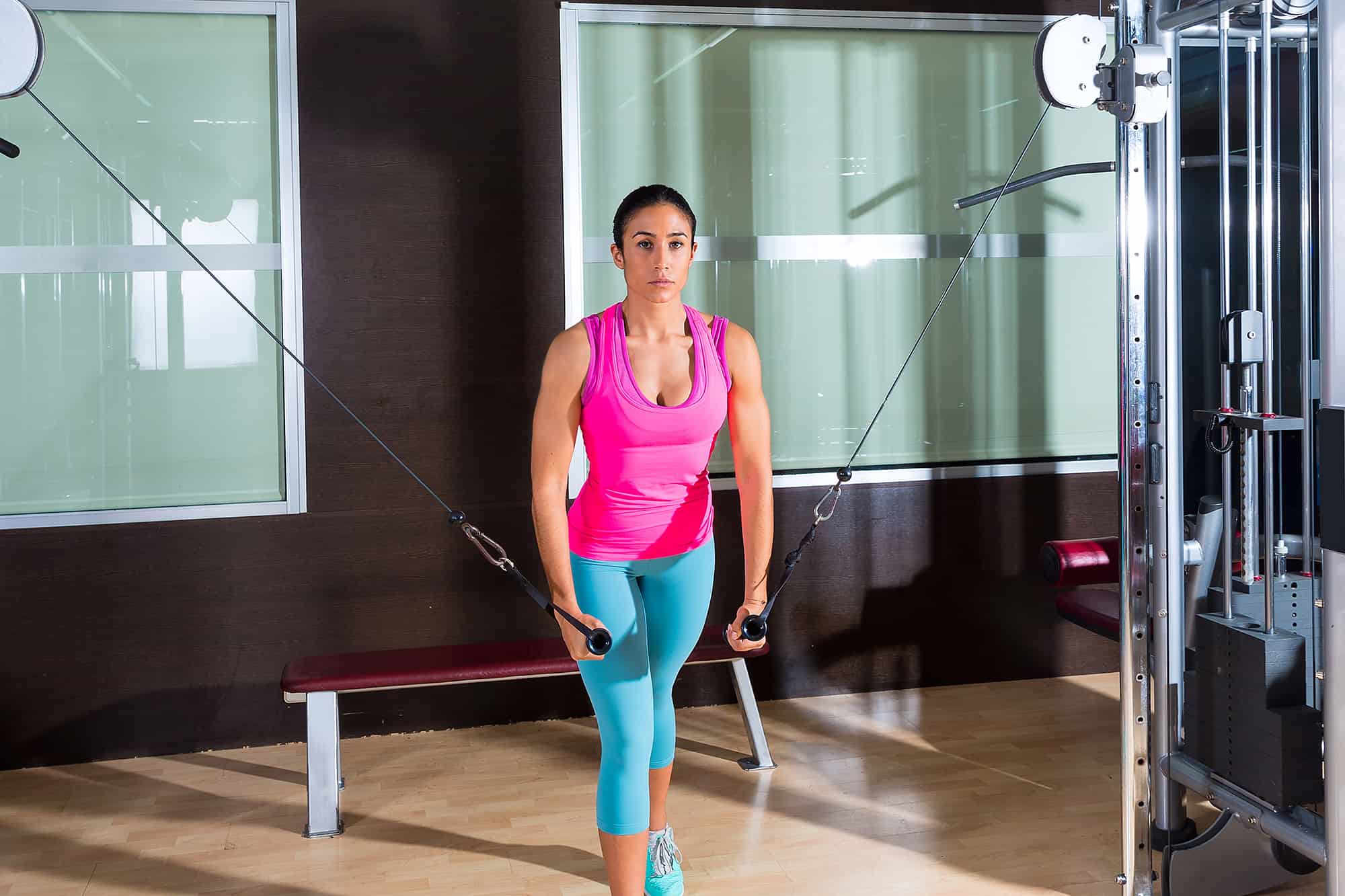The cable chest fly does not exhaust you like lunges or squats and does not embarrass you like pull-ups. The chest cable fly exercise gives you a pump in your chest muscles, essential for increasing muscular strength in the upper body.
Cable chest flys are an effective way of engaging the pectorals. If you experience discomfort in your joints using the bench press, cable chest flys are a forgiving alternative.
If this exercise is something you intend to incorporate into your fitness program, read on to understand how to do it correctly, how it works, and more.
Key Takeaways
- The chest fly is a great way to build pectoral muscles.
- It is important to understand how the cable machine works and how to take the right form during the movements and variations.
Table of Contents
How To Do The Cable Chest Fly
It is essential to have a proper posture when doing this exercise (if you want to get all the benefits and lower the risk of injury).
Starting Position
- Set the pullers on a chest fly machine to your chest height, preferably the dual cable one.
- Stand between the two stacks and take a neutral posture.
- Grab the handles to start.
Execution
Here is a step-by-step guide on how to do chest flys.
- Keep your back straight, engage your core and raise your arms out to the sides.
- Ensure your palms are facing forward before moving.
- Create some tension on the cables.
- Set one foot in front of the other to take the stance.
- Bend your elbows slightly. Ensure the elbows do not go behind your shoulders.
- Pull your hands, bringing them towards each other in wide arcs.
- Ensure you bring the hands in front of you and pause when the hands touch.
- Slowly return to the starting position.
- Alternate the forward foot with each set.
Making The Cable Chest Fly Harder
The standing cable fly works on a single muscle group.
Over time, you will want to add the weights as you would with any other strength training workouts; but, you would need to do so slowly.
The best way is to change the tempo by slowing down the negative phase and holding the contracted position for a few more seconds. This will increase your time under tension, which is essential for muscle growth [1].
Another way is by letting the handles go halfway through the rep and bringing them together fully again. This movement, together with a deep squeeze of your muscles, will increase time under tension.
This method makes the set considerably harder because you will be doing the most challenging part of the exercise, twice per rep.
Essential Tips
Before Working Out
Ensure you have eaten a wholesome meal before your workout (to fuel your muscles). Diet plays a significant role in building strength; therefore you should focus on a balanced, nutritious diet.
Your diet should contain whole carbohydrates, protein, vitamins, minerals and fats. Also, ensure you are hydrated and in comfortable clothes before your training session.
Using The Chest Fly Machine
Generally, the tool is beginner-friendly and safe to use for all fitness levels. However, like other strength training workouts and machines, it is vital to take precautions to prevent injury.
A safety tip is to give yourself room when working out. This tool takes vast amounts of floor space; therefore, you want to make sure you have enough wiggle room to accommodate the movements.
Ask your trainer for advice on setting the right height. If you are starting, it would be best to ask for instructions on how to use the tool. Having the proper form will ensure you use the tool effectively and minimise chances for injury.
During The Workout
Like free weights such as dumbbells and other power training machines, go slow and choose weights that are comfortable for you.
Ensure the weight does not affect your posture and adjust accordingly. Seek advice from your trainer. If you find it challenging to maintain the posture, reduce the resistance to prevent injury [2].
Keep your back as straight as possible, and avoid slouching when stretching your hands out. A straight back will reduce the pressure you exert on your spine. Again, if you feel like you have to bend your back, reduce the resistance.
It may be tempting to hold your breath as you engage your muscles. This can be helpful as you add the weight but can add on to the difficulty of the workout. Instead, release your breath and reset with each move.
The best way is to exhale as you bring the arms together in front of you. Inhale as you return the handles to the starting position.
Avoid using your legs to exert power during the closing movements. The purpose of the movement is to work your pectorals and not your legs. Instead, use your chest and shoulders.
If you find yourself using your legs for stability, decrease the weight you are lifting.
Lastly, when doing the chest fly, use slow, controlled movements. If you go too quickly, you will be using your hands’ natural momentum rather than training your pecs.
FAQ
What Are The Benefits Of The Cable Chest Fly?
One of the outstanding benefits of the cable chest fly exercise is its suitability for people that experience discomfort and joint pain during the bench press. This workout ensures shoulder -blade stability, by changing the angle of the move to reduce stress on the joints.
Another benefit is that this exercise places lots of tension on the muscle throughout the stretch.
It gives your pecs uninterrupted time under tension and a deep pump, beneficial for optimal muscle growth. This is not something you would get with dumbbell flys.
Which Chest Muscles Does The Cable Chest Fly Target?
This is one of the exercises that work on the pectoral muscles, that is, the pectoralis major and the pectoralis minor [3].
Of the two, the pec major is the only one visible as it is the outermost layer. It powers the adduction of the arms, bringing them together to hug, clap or lock hands.
The pec minor is under and works to draw the shoulder blades forward and down.
When doing the chest fly, an upward angle targets the upper or the clavicular while a lower angle targets the lower or sternal part of the muscle. If you are looking into working out your upper chest, then adopting a low-to-high move will get you the best results.
How Often Should You Use The Cable Machine?
You should schedule your chest flys like any other weight training exercises. The tool is adaptable and can be used to train different muscle groups. If you use it solely for the chest, then you should use it only on chest days.
Aim to do 10 to 12 reps, 2 to 3 sets. Going ham on the equipment not only creates a potential risk for injury but also tires your muscles.
After using the equipment, give your pecs a break and focus on another single muscle group, (say on the lower body).
Is The Standing Cable Fly Better Than The Seated Cable Fly?
The standing cable fly requires additional control of the core. It also requires a higher body weight to strength ratio than the seated fly. That said, if you are strong but light, it may be challenging to do the standing cable fly.
In such a case, you may need to use a bench with a back for additional stability. That will allow you to concentrate on muscle engagement in your chest and the full range of motion.
The Bottom Line
The chest fly exercise is a great way to build muscle mass and increase strength in your upper body. It is not only beginner-friendly but also easily adaptable to meet your needs. If you are considering adding it to your fitness program, the tips above will be helpful.
References
- https://pubmed.ncbi.nlm.nih.gov/23825696/
- https://www.mayoclinic.org/healthy-lifestyle/fitness/in-depth/weight-training/art-20047116
- https://www.nchpad.org/374/2112/Strengthening~Exercises






